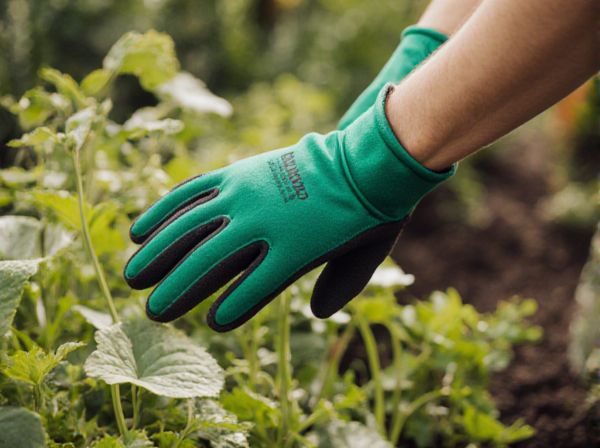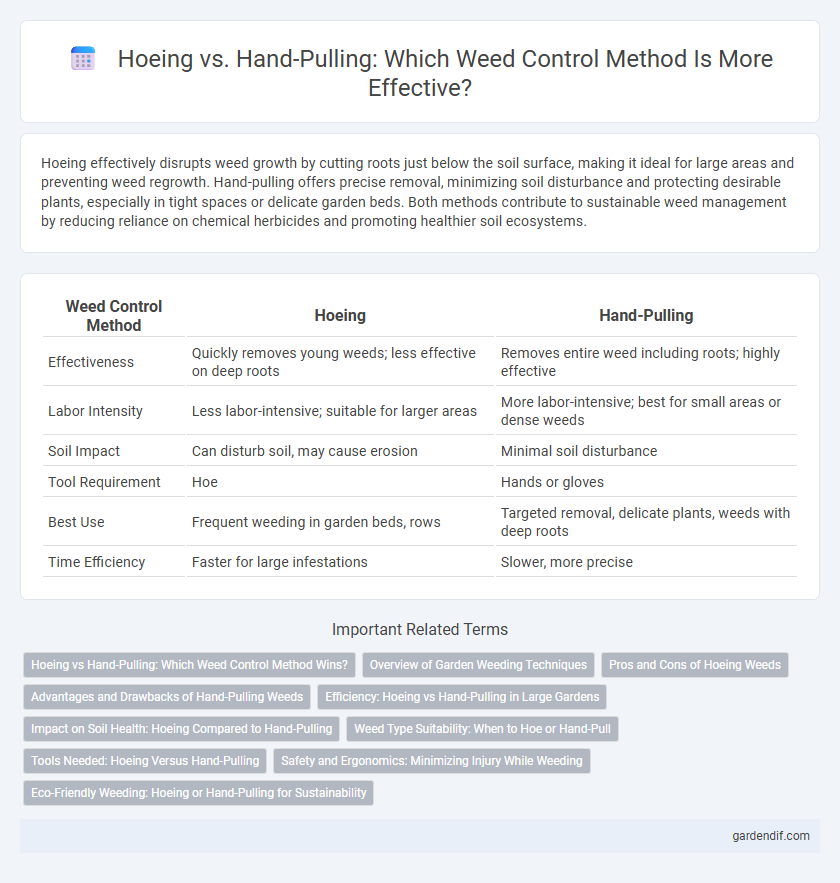
Hoeing vs hand-pulling Illustration
Hoeing effectively disrupts weed growth by cutting roots just below the soil surface, making it ideal for large areas and preventing weed regrowth. Hand-pulling offers precise removal, minimizing soil disturbance and protecting desirable plants, especially in tight spaces or delicate garden beds. Both methods contribute to sustainable weed management by reducing reliance on chemical herbicides and promoting healthier soil ecosystems.
Table of Comparison
| Weed Control Method | Hoeing | Hand-Pulling |
|---|---|---|
| Effectiveness | Quickly removes young weeds; less effective on deep roots | Removes entire weed including roots; highly effective |
| Labor Intensity | Less labor-intensive; suitable for larger areas | More labor-intensive; best for small areas or dense weeds |
| Soil Impact | Can disturb soil, may cause erosion | Minimal soil disturbance |
| Tool Requirement | Hoe | Hands or gloves |
| Best Use | Frequent weeding in garden beds, rows | Targeted removal, delicate plants, weeds with deep roots |
| Time Efficiency | Faster for large infestations | Slower, more precise |
Hoeing vs Hand-Pulling: Which Weed Control Method Wins?
Hoeing rapidly disrupts weed growth by cutting weeds just below the soil surface, making it highly effective for managing large garden areas and preventing weed competition with crops. Hand-pulling offers precision, targeting individual weeds and roots, ideal for delicate plants or areas where hoeing risks soil disturbance. Choosing between hoeing and hand-pulling depends on garden size, weed type, and plant sensitivity, with hoeing favored for speed and efficiency and hand-pulling preferred for thoroughness and minimal soil disruption.
Overview of Garden Weeding Techniques
Hoeing efficiently removes young weed seedlings with minimal soil disturbance, promoting aeration and moisture retention in garden beds. Hand-pulling targets mature weeds, ensuring complete root removal and reducing the likelihood of regrowth, especially for deep-rooted species. Combining both methods enhances overall weed control by addressing different growth stages and minimizing garden stress.
Pros and Cons of Hoeing Weeds
Hoeing weeds offers efficient removal by cutting weed roots just below the soil surface, minimizing soil disturbance and accelerating the weeding process. It is highly effective for annual weeds and large areas but may struggle with deep-rooted perennials and risks damaging nearby crops if not used carefully. While hoeing reduces labor intensity compared to hand-pulling, it lacks the precision to remove individual weeds entirely, potentially allowing regrowth.
Advantages and Drawbacks of Hand-Pulling Weeds
Hand-pulling weeds offers precise removal by targeting individual plants, minimizing soil disturbance and preserving beneficial organisms. This method is cost-effective and environmentally friendly, avoiding chemical use and reducing herbicide resistance. However, hand-pulling can be labor-intensive and less effective for deep-rooted or extensive weed infestations, requiring frequent repetition to prevent regrowth.
Efficiency: Hoeing vs Hand-Pulling in Large Gardens
Hoeing offers greater efficiency in large gardens by covering extensive areas quickly and minimizing physical strain compared to hand-pulling. While hand-pulling provides precision in removing deep-rooted weeds, hoeing disrupts weed seedlings before they establish, reducing labor time significantly. Combining both methods can optimize weed control by balancing speed and thoroughness in expansive garden settings.
Impact on Soil Health: Hoeing Compared to Hand-Pulling
Hoeing disrupts soil structure more significantly than hand-pulling, potentially leading to soil compaction and erosion over time. Hand-pulling targets weeds directly with minimal disturbance to the surrounding soil microbiome, preserving soil aeration and moisture retention. Consistently using hand-pulling supports long-term soil health by maintaining organic matter and promoting beneficial microbial activity.
Weed Type Suitability: When to Hoe or Hand-Pull
Hoeing is ideal for managing shallow-rooted annual weeds such as crabgrass and chickweed, as it efficiently disrupts their growth near the soil surface. Hand-pulling suits deep-rooted or perennial weeds like dandelions and bindweed, where careful removal prevents regrowth from root fragments. Selecting the appropriate method depends on weed species, root depth, and soil conditions to ensure effective weed control and minimize plant disturbance.
Tools Needed: Hoeing Versus Hand-Pulling
Hoeing requires a sharp, sturdy hoe designed to cut weed stems just below the soil surface, making it efficient for large areas and deep-rooted weeds. Hand-pulling demands strong, gloved hands and sometimes a weeding fork or trowel to grasp and extract weeds completely, including roots, from the soil. Both methods benefit from tools that minimize soil disturbance and promote healthy plant growth.
Safety and Ergonomics: Minimizing Injury While Weeding
Hoeing reduces physical strain by allowing gardeners to maintain an upright posture, which minimizes back and joint stress compared to bending for hand-pulling. Using ergonomic hoes with padded grips further prevents repetitive strain injuries and improves safety during extended weeding sessions. Hand-pulling requires frequent kneeling or stooping, increasing the risk of muscle fatigue and injury, especially without proper support or protective gloves.
Eco-Friendly Weeding: Hoeing or Hand-Pulling for Sustainability
Hoeing and hand-pulling are eco-friendly weeding methods that reduce chemical usage, promoting sustainable gardening. Hoeing disrupts weed roots just below the soil surface, preventing regrowth without harming beneficial microbes, while hand-pulling ensures complete removal of deep-rooted weeds. Both techniques enhance soil health, support biodiversity, and minimize environmental impact compared to herbicides.
Hoeing vs hand-pulling Infographic

 gardendif.com
gardendif.com